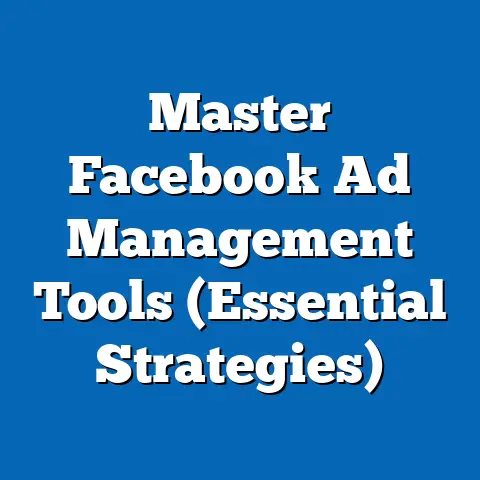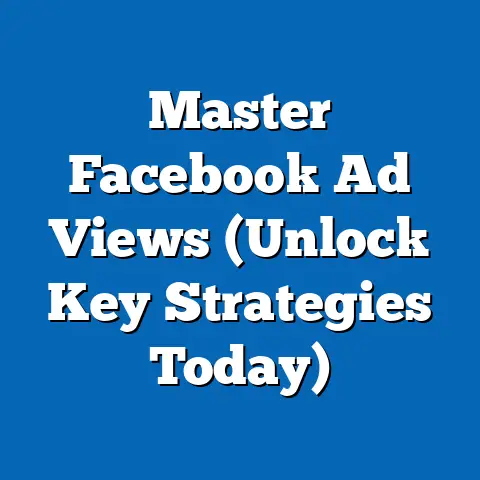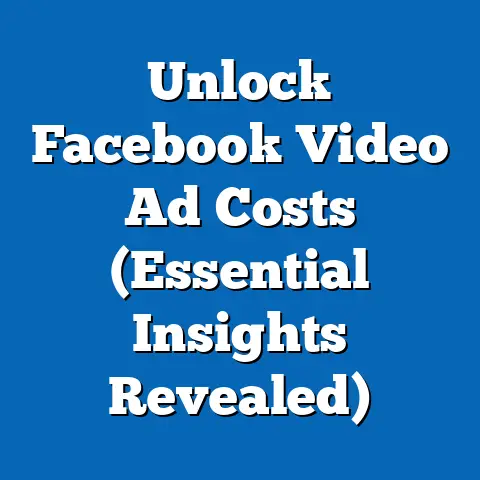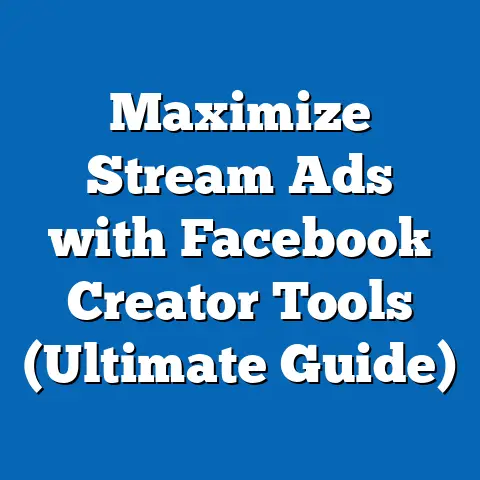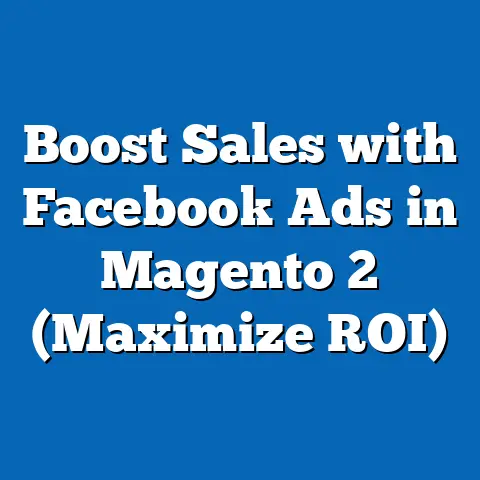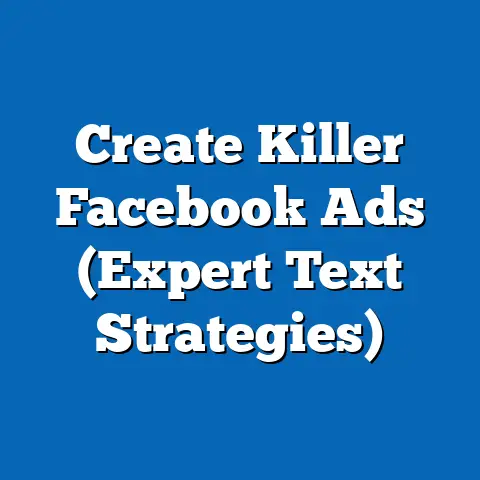Unlocking Effective Facebook Ad Calls (Proven Strategies)
Would you rather spend hundreds of dollars on Facebook ads with little to no return, or unlock a treasure trove of effective strategies that could double your conversion rates overnight? The truth is, even the most visually stunning ad can fall flat if it lacks a compelling call to action (CTA). In the ever-evolving world of digital marketing, crafting the perfect CTA on your Facebook ads isn’t just a suggestion – it’s a necessity. I’ve seen firsthand how a well-structured Facebook ad, armed with a persuasive CTA, can make a significant difference in a business’s marketing success, leading to higher engagement, better conversion rates, and ultimately, a boost in sales.
Think of your Facebook ad as a salesperson. It grabs attention, presents a product or service, and then… well, it needs to close the deal! That’s where the CTA comes in. It’s the final push, the gentle nudge, or the irresistible offer that compels users to take the next step. In this article, I’ll delve into proven strategies for crafting CTAs that convert, backed by psychological principles, real-world examples, and actionable tips you can implement today. Forget wasted ad spend; let’s unlock the potential of your Facebook ads together!
Understanding the Basics of Facebook Ads
Before we dive into the nitty-gritty of crafting killer CTAs, let’s establish a solid foundation. Facebook ads, at their core, are a powerful tool for reaching a massive and highly targeted audience. But simply throwing money at Facebook and hoping for the best is a recipe for disaster. You need to understand the basic building blocks of an effective ad.
A typical Facebook ad consists of several key elements:
- Visuals: This could be an image, video, or carousel of images. The visual is often the first thing users see, so it needs to be eye-catching and relevant to your target audience.
- Headline: A short, attention-grabbing line of text that summarizes the ad’s main message.
- Ad Copy: The body text of the ad, providing more details about the product or service being offered.
- Call to Action (CTA) Button: The button that prompts users to take a specific action, such as “Learn More,” “Shop Now,” or “Sign Up.”
Beyond the structure of the ad itself, targeting is paramount. Facebook’s robust targeting options allow you to reach specific demographics, interests, behaviors, and even custom audiences based on your existing customer data. Without proper targeting, your ad is like a ship sailing without a compass, likely to get lost at sea (or, in this case, lost in the newsfeed). I’ve seen campaigns completely transform simply by refining the targeting parameters.
The Facebook algorithm plays a crucial role in determining which ads are shown to which users. The algorithm considers factors like ad relevance, bid amount, and estimated action rates (how likely users are to engage with your ad) to optimize ad delivery. Understanding how the algorithm works can help you create ads that are more likely to be seen and engaged with by your target audience.
Finally, you need to track the right metrics to measure your ad’s success. Key metrics include:
- Click-Through Rate (CTR): The percentage of users who see your ad and click on it.
- Conversion Rate: The percentage of users who click on your ad and complete a desired action, such as making a purchase or filling out a form.
- Engagement: Likes, comments, shares, and other interactions with your ad.
- Cost Per Acquisition (CPA): The cost of acquiring one customer through your ad campaign.
By consistently monitoring these metrics, you can identify what’s working and what’s not, and make adjustments to optimize your ad performance. Think of it as a continuous feedback loop – analyze, adjust, repeat.
Key Takeaway: A successful Facebook ad is a carefully crafted combination of compelling visuals, persuasive copy, precise targeting, and continuous optimization. Understanding these fundamentals is crucial before we delve into the art of crafting effective CTAs.
The Psychology Behind Effective Calls to Action
A CTA isn’t just a button; it’s a psychological trigger. To create truly effective CTAs, you need to understand the underlying principles that drive human behavior. What motivates people to click? What makes them take action? Let’s explore some key concepts:
- Urgency: People are more likely to act when they feel a sense of urgency. This could be created by highlighting a limited-time offer, a limited quantity of products, or an upcoming deadline. Phrases like “Limited Time Only!” or “While Supplies Last!” can be incredibly effective.
- Scarcity: Similar to urgency, scarcity plays on the fear of missing out (FOMO). When people believe that something is scarce or exclusive, they’re more likely to want it. Phrases like “Only a Few Spots Left!” or “Exclusive Offer!” can create a sense of scarcity.
- Clarity: Your CTA should be crystal clear about what users will get when they click on it. Ambiguity can lead to hesitation and lost conversions. Avoid vague phrases like “Click Here.” Instead, use specific and descriptive language like “Download Your Free Ebook” or “Get Started Today.”
- Value Proposition: Your CTA should clearly communicate the value proposition of your offer. What will users gain by taking action? Will they save money, learn something new, or solve a problem? Make sure the benefits are clear and compelling.
- Emotional Triggers: Emotions play a significant role in decision-making. Tap into emotions like excitement, curiosity, or even fear to prompt action. For example, an ad for a security system might use a CTA like “Protect Your Family.”
I once ran a campaign for a local bakery offering a free cookie with every purchase. The original CTA was simply “Learn More.” After switching it to “Claim Your Free Cookie!” we saw a 40% increase in click-through rates. Why? Because the new CTA was clear, specific, and highlighted the value proposition (a free cookie!).
The color of your CTA button can also influence click-through rates. While there’s no magic color that works for everyone, testing different colors can reveal what resonates best with your target audience. Consider the overall design of your ad and choose a color that stands out without clashing.
Key Takeaway: Effective CTAs are not just about what you say; they’re about understanding why people click. By incorporating psychological principles like urgency, scarcity, clarity, and emotional triggers, you can create CTAs that resonate with your target audience and drive conversions.
Proven Strategies for Crafting Effective Facebook Ad Calls
Now that we’ve covered the basics and the psychology behind effective CTAs, let’s dive into some specific strategies you can use to improve your Facebook ad performance.
Strategy 1: Use Action-Oriented Language
As I mentioned earlier, strong verbs are your best friends when crafting CTAs. They create a sense of urgency and encourage immediate action. Instead of “More Info,” try “Discover More.” Instead of “Sign Up,” try “Join Now.” Here are some examples of action-oriented verbs you can use:
- Discover: “Discover the secrets to…”
- Join: “Join our community…”
- Get: “Get your free trial…”
- Shop: “Shop our latest collection…”
- Download: “Download your free ebook…”
- Learn: “Learn more about…”
- Start: “Start your free trial…”
I’ve found that using the word “You” in your CTA, especially when appropriate, can also significantly improve response rates. For example, instead of “Get a Free Quote,” try “Get Your Free Quote.” It makes the CTA feel more personalized and relevant to the individual user.
Strategy 2: Create a Sense of Urgency or Scarcity
Urgency and scarcity are powerful motivators. Use them judiciously and ethically to encourage immediate action. Here are some techniques you can use:
- Time-Limited Offers: “Sale Ends Tonight!” or “Offer Expires in 24 Hours!”
- Limited Stock Alerts: “Only 5 Left in Stock!” or “Selling Out Fast!”
- Early Bird Discounts: “Sign Up Now and Save 20%!”
- Limited-Time Free Shipping: “Free Shipping on Orders Over $50 – Ends Soon!”
However, be careful not to overuse these tactics or make false claims. Authenticity is crucial, and users will quickly lose trust if they feel like they’re being manipulated. Make sure your offers are genuine and that you can deliver on your promises.
Strategy 3: Personalization and Relevance
Tailoring your CTA to specific audience segments can significantly improve response rates. Use Facebook’s targeting options to create ads that are highly relevant to different demographics, interests, and behaviors.
For example, if you’re advertising a fitness program, you might create separate ads for different age groups or fitness levels. The CTA for a younger audience might be “Get Shredded Now!” while the CTA for an older audience might be “Improve Your Health Today!”
You can also personalize your CTAs based on user behavior. For example, if someone has previously visited your website, you might show them an ad with a CTA like “Continue Shopping” or “Complete Your Purchase.”
Strategy 4: Testing and Optimization
A/B testing is essential for finding the most effective CTAs. Create multiple versions of your ad with different CTAs and track their performance. Facebook’s Ads Manager makes it easy to run A/B tests and compare results.
Test different variations of your CTAs, including:
- Wording: Try different verbs, phrases, and value propositions.
- Button Color: Experiment with different colors to see what resonates best with your audience.
- Button Size: See if a larger or smaller button performs better.
- Button Placement: Test different placements of the CTA button within your ad.
Pay close attention to your metrics (CTR, conversion rates, CPA) to determine which CTAs are performing best. Don’t be afraid to experiment and iterate. The key is to continuously test and optimize your CTAs based on data.
Strategy 5: Aligning CTAs with Ad Objectives
Your CTA should always align with the specific goals of your ad campaign. Are you trying to build brand awareness, generate leads, or drive sales? Your CTA should reflect that goal.
- Brand Awareness: “Learn More,” “Discover More,” “See What’s New”
- Lead Generation: “Sign Up,” “Get a Free Quote,” “Download Our Guide”
- Sales: “Shop Now,” “Buy Now,” “Get Your Discount”
For example, if you’re running an ad to promote a new product, your CTA should be “Shop Now” or “Buy Now.” If you’re running an ad to generate leads for your email list, your CTA should be “Sign Up” or “Download Our Free Ebook.”
Key Takeaway: Crafting effective Facebook ad calls requires a strategic approach. By using action-oriented language, creating a sense of urgency or scarcity, personalizing your CTAs, testing and optimizing your ads, and aligning your CTAs with your ad objectives, you can significantly improve your ad performance and drive conversions.
Case Studies of Successful Facebook Ad Campaigns
Let’s take a look at some real-world examples of brands that have successfully implemented effective CTAs in their Facebook ads.
Case Study 1: Airbnb
Airbnb is a master of personalization. They use Facebook’s targeting options to show users ads for accommodations in locations they’ve previously searched for. Their CTAs are clear, specific, and aligned with their ad objective (driving bookings). For example, an ad might show a beautiful beachfront villa with a CTA like “Book Your Stay Now!”
Key Learning: Personalization is key. Tailor your CTAs to specific user interests and behaviors to improve response rates.
Case Study 2: Dollar Shave Club
Dollar Shave Club uses humor and a strong value proposition to attract new subscribers. Their Facebook ads often feature funny videos with a clear CTA like “Join the Club.” This CTA is simple, direct, and encourages users to take the next step in the customer journey.
Key Learning: Don’t be afraid to inject personality into your ads. Humor can be a powerful tool for grabbing attention and driving engagement.
Case Study 3: HubSpot
HubSpot is a marketing automation platform that relies heavily on lead generation. Their Facebook ads often promote free resources like ebooks and webinars with CTAs like “Download Our Free Ebook” or “Register for Our Webinar.” These CTAs are clear, specific, and offer a valuable incentive for users to take action.
Key Learning: Offer valuable resources in exchange for leads. Free ebooks, webinars, and other resources can be a great way to attract new customers and build your email list.
Case Study 4: Warby Parker
Warby Parker is an online eyewear retailer that offers a unique home try-on program. Their Facebook ads often feature stylish glasses with a CTA like “Try 5 Frames at Home for Free.” This CTA is compelling because it removes the risk of buying glasses online and allows users to try them on in the comfort of their own homes.
Key Learning: Remove barriers to purchase. Offer free trials, free shipping, or other incentives to make it easier for customers to buy from you.
Key Takeaway: These case studies demonstrate the importance of crafting CTAs that are clear, specific, personalized, and aligned with your ad objectives. By learning from the successes of other brands, you can improve your own Facebook ad performance and drive conversions.
Conclusion
Crafting effective CTAs for your Facebook ads is a critical skill that can significantly impact your marketing success. By understanding the basics of Facebook ads, the psychology behind effective CTAs, and the proven strategies outlined in this article, you can unlock the potential of your ad campaigns and drive conversions.
Remember, effective CTAs are:
- Action-oriented: Use strong verbs to encourage immediate action.
- Urgent or scarce: Create a sense of urgency to motivate users to act now.
- Personalized: Tailor your CTAs to specific audience segments.
- Tested and optimized: Continuously test and refine your CTAs based on data.
- Aligned with ad objectives: Ensure your CTAs support your overall marketing goals.
Don’t underestimate the transformative power of a well-crafted call to action. By implementing these proven strategies in your own campaigns, you can turn your Facebook ads into a powerful engine for growth. So, go forth, experiment, and watch your conversion rates soar! The world of Facebook advertising awaits, armed with your newfound knowledge and a killer CTA. Now, go make it happen!

